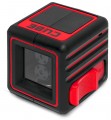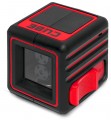—
holder. Devices for fixing the level / range finder on various surfaces. Such a device differs from a tripod primarily in its small size — within a couple of tens of centimeters. On the other hand, most holders allow you to install the device not only on horizontal, but also on vertical surfaces — for example, walls (and some are exclusively wall-mounted). Anyway, this function greatly expands the installation possibilities.
—
Receiver. laser radiation supplied with the device. This device is usually equipped with laser levels, less often with rangefinders, and it is not required at all for optical instruments. The main purpose of the receiver is situations where the laser mark is not visible to the naked eye — for example, at a long distance or in bright light. More details on the features of its application are described above in the paragraph “Measurement range (with receiver)”.
—
Tripod. Most modern instruments have a standard size thread and can be used with any suitable tripod. On the other hand, a complete tripod is most often specially designed for a certain model and optimally matches it in terms of general characteristics. In addition, this configuration option relieves you of the need to look for and purchase a suitable tripod yourself.
—
Case / case. The main function of these devices is to protect
...the device from bumps, scratches, dirt, temperature changes and other adverse effects; for this, of course, improvised means can also be used, but specialized protection is usually both more convenient and more reliable. In addition, almost all cases and most covers greatly simplify the transportation of the tool — in particular, due to the fact that they can also be used for complete accessories.
— Remote control. Among rangefinders and optical levels, this function is practically not found, because. working with them involves the constant stay of the device in the hands of the operator. But for laser levels that require you to regularly move from the device to the surface to be marked and back, the remote control can be a very useful addition — due to the fact that it minimizes such movements. For example, after marking the "front of work" on the wall according to the projection from the level, you do not have to approach the device to turn it off — just give a command from the remote control. At short distances, the savings in time and effort may not be so obvious, but over large areas, they can become quite noticeable.
